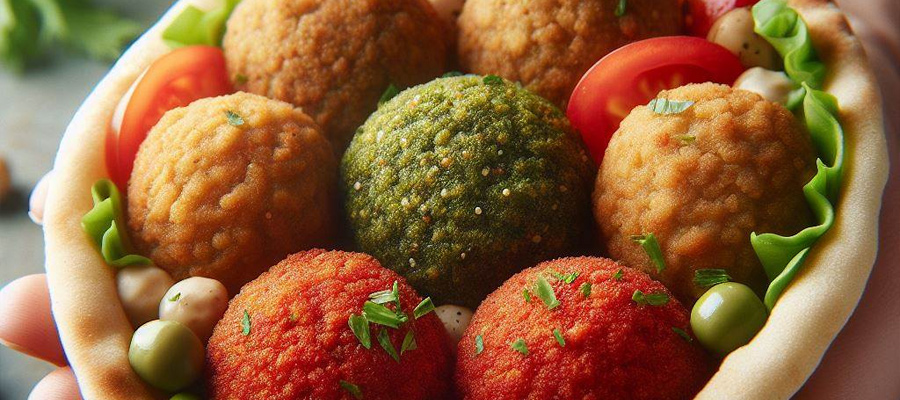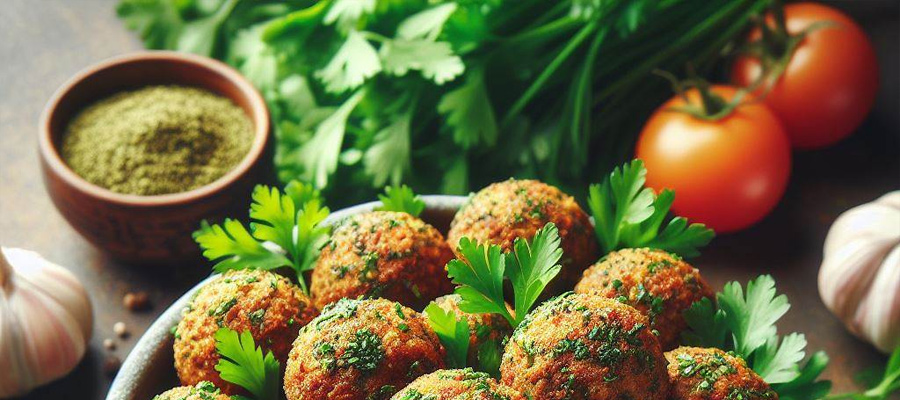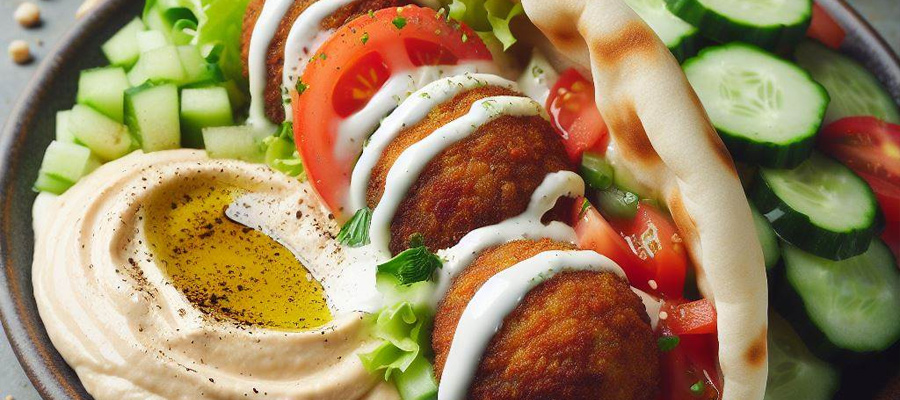What is Falafel?
The epitome of Middle Eastern Food, when you ask someone about their favorite dish from the region, most will happily say falafel.
You’ve been enjoying falafel from your favorite restaurant for years, but do you really know the origins of falafel and that there are several different ways to create and present this incredible dish?
Whether you prefer medium-heat Israeli falafel or a tame, baked falafel made with dried fava beans, there is a falafel for anyone’s tastes and preferences.
Here is the definitive guide to Falafels and how to perfect Middle Eastern cooking in your own kitchen:
History of Falafel
Scholars are debating the exact origin of falafel. Many believe the dish originated in Egypt and was first consumed by the Coptic Christians as a meat-alternative meal during Lent.
Other historians argue that the falafel is much older and was enjoyed by the pharaohs of Egypt or that it originated in India.
Traditional falafel is made from either fava beans or chickpeas, a mixture of spices, and is fried and presented with a dipping sauce, particularly tahini sauce.
Deep Fried Falafel: A Middle Eastern Delicacy That Is Popular Street Food Across the Globe
Falafel’s history is diverse and confusing, but one thing cannot be disputed: This once-regional delicacy quickly spread across the globe and became a global street food phenomenon.
Chickpeas and fava beans are commonplace ingredients throughout the Middle East and Africa, and it is not surprising that different falafel recipes spread across the trade routes for several centuries.
Although falafel has been enjoyed for centuries, it rose in prominence throughout the United States during the late 20th century when people who adopted the vegetarian or vegan lifestyle were looking for an alternative to highly processed foods.
However you came to know and love falafel, whether it was in your mother’s kitchen, your favorite Middle Eastern restaurant, or food truck, there is no denying that this hearty dish will continue to remain popular for several centuries to come!
Tips to Cook Falafel in Your Own Home
The rise of COVID-19 and recent lockdowns have prompted many to try their hand at making their all-time favorite dishes in the comfort and safety of their very own kitchen.
You are ready to make falafel but aren’t sure where to begin or if the frying process or baking falafel is the better option.
Here are a few simple tips to help get you started and, hopefully, prevent several unnecessary trips to the grocery store for overlooked tools and ingredients:
Gather the Necessary Equipment and Supplies
Despite its complex flavor profile, falafel is a relatively simple and straightforward dish to create at home.
To make the process easier, make sure to have the right equipment and supplies on hand, including:
- A food processor
- Medium saucepan or deep fryer
- Slotted spoon or metal strainer
- Large bowl
Of course, the necessary equipment and supplies depend on your preferences and preparation method. If you plan to fry the falafel mixture, a traditional albeit less healthy method, you will need oil, preferably sunflower, rapeseed, or canola oil.
Use Fresh Parsley, Fresh Ground Coriander, and Other Fresh Ingredients
If you have tried and failed at making homemade falafel in the past, chances are the most significant issues you faced were two-fold: Relying on canned chickpeas or canned beans and not using fresh ingredients.
Middle Eastern restaurants pride themselves on only using the freshest, finest ingredients, from parsley and cilantro to cumin, garlic, and other fresh veggies.
Are you in a pinch and want to upgrade a store-bought falafel mix? Add some fresh parsley, cilantro, or other fresh vegetables to the mixture to make it taste more authentic and authentically homemade!
Can You Bake a Traditional Falafel Recipe Rather than Deep Frying?
There are two traditional ways to cook falafel: Drop the patties or balls into hot oil or bake the falafel in the oven. If you have an air fryer, you can also bake your falafel in half the time as a typical convection oven!
Prevent your falafel from sticking by placing the balls or patties on a baking sheet lined with parchment paper.
Be aware that while it is healthier, you will not typically achieve as crunchy of a texture as you would if you deep-fried the falafel, but the health benefits are often well worth the change in consistency.
Put Down Your Store Bought Falafel Mixture and Follow This Simple Recipe!
Are you excited to try your hand at making fried or cooked falafel for your next family meal or holiday party?
Here are the ingredients for an authentic falafel recipe:
- One bag of dry chickpeas (not canned chickpeas)
- One yellow onion
- Ten fresh garlic cloves
- One bundle of fresh parsley leaves
- One bundle of fresh cilantro leaves
- One teaspoon salt
- 1/2 teaspoon black pepper
- One teaspoon of ground cumin
- 1/2 teaspoon baking soda or substitute with baking powder
- 2-3 tablespoons chickpea flour
Always use dried chickpeas, never canned, to ensure you achieve the perfect, authentic falafel’s crunchy yet soft and complex texture.
Remember, only use fresh herbs and ingredients, and the chopped onion should be fine to prevent overpowering the remaining ingredients.
Prefer light, fluffy falafel: Add a bit more baking soda or baking powder into the prepared mixture!
Traditional Israeli falafel often calls for red pepper flakes, while many makers of traditional Lebanese falafel add green onions to their dough mixture.
Preparation of Your Falafel Balls
- Soak overnight the dry chickpeas
- Add all ingredients to a food processor
- Let the falafel mixture rest for 30 minutes in the fridge
- Heat up the cooking oil to 350°-355°
- Make falafel balls using a falafel scoop maker and a flat tablespoon.
- Fry the falafel in canola, sunflower, rapeseed, or vegetable oil until golden brown.
Aren’t sure if you have achieved the ideal texture? The consistency of perfectly formed falafel balls or patties should resemble a coarse meal and should never be damp or soggy.
Chilling the falafel mixture for at least 30 minutes to one hour helps it hold together better.
Form the falafel by hand or a falafel maker, which is found at most kitchen supply or big box stores.
Deep fry falafel until golden brown and have a baking sheet lined with kitchen or paper towels for the hot, newly fried patties or balls.
How to Effortlessly Bake Falafel
Baking your falafel is a traditional and healthier alternative to frying.
Follow these simple steps to bake or air fry your falafel mixture perfectly:
- Preheat the oven to 375 degrees.
- Prepare the falafel mixture according to the steps outlined above.
- Press the balls into patties one-half inch thick.
- Brush the patties with a small amount of extra virgin olive oil.
- Bake for 10 to 15 minutes.
- Flip the falafel over and bake for 10 minutes longer or until golden brown.
If you prepared too much falafel mixture, you could refrigerate the leftovers for up to five days.
Prefer to air fry your falafel? Prepare the mixture the same way and air fry the dough patties or balls in five-minute increments at 400 degrees until golden and cooked through.
Try This Amazing Falafel Sandwich Recipe!
Did you know that the word falafel refers to the balls themselves or the sandwich traditionally made with pita bread?
How to make a falafel sandwich:
- Cut open the edge of a warm pita.
- Spread hummus.
- Add four falafel balls.
- Add diced Israeli salad (cucumber, tomato, red onion, lemon juice, extra virgin olive oil or olive oil, salt, and black pepper).
- Add sour sauerkraut and sliced pickles.
- Add four more falafel balls.
- Top with tahini sauce.
If you find pita bread too dry and brittle, try making an updated falafel sandwich with flatbread or naan instead.
Substitute the hummus and Israeli salad with a yogurt-based or Tzatziki, a traditional sauce made from cucumber, yogurt, and dill.
Don’t Forget the Tahini Sauce!
A conventional dipping or side sauce for falafel, tahini is made from a mixture of hulled sesame seeds, oil, and salt.
The seeds are typically toasted before emulsified with oil to create a pourable consistency.
The texture is smooth, and the taste is earthy and aromatic, but don’t confuse tahini sauce with hummus.
Tahini is a main ingredient in hummus, but to make an authentic hummus, you must combine dried, whole, or ground chickpeas with tahini, lemon, olive oil, garlic, salt, and black pepper.
Fava Beans vs Chickpeas: Which Is Better for Your Homemade Falafel?
There is a debate raging in the falafel community about which is the best type of soaked beans for an authentic falafel.
The origins of falafel are dubious and highly debated, and each Middle Eastern country has its own take on how to make the ideal falafel.
For example, for a traditional street falafel in Palestine, chefs will often combine a mixture of equal parts fava beans and chickpeas.
Many Egyptians will make Ta’ameya, or Egyptian falafel, with fava beans rather than chickpeas, while soaked chickpeas are the preferred option for Indian falafel.
Ultimately, the best legume for your falafel is a matter of personal preference and what you have handy inside your pantry!
Soak Your Garbanzo Beans Overnight
Remember, you need to soak the beans for at least 12 hours before adding them to the food processor.
Add the baking powder or baking soda into the large bowl filled with water and beans to help them soften more quickly and efficiently.
Cover the large bowl with a tight-fitting lid or plastic wrap and squeeze any excess water out of the beans before adding them to the processor or blender.
Did You Forget to Soak? The Fast-Soaking Method Explained
Are you in a pinch and need to soak your chickpeas ASAP? There is a quick soak method that will do, but you might notice a slight difference in the texture.
Here is how to quickly soak your beans to make a fast falafel recipe:
- Rinse the beans well under cool or lukewarm running water.
- Squeeze out any excess moisture.
- Pour the beans into a large pot and fill it with water; the water should be at least two to three inches above the beans.
- Bring the pot to a near-boil.
- Pull the pot off the stove’s heat and let it sit covered for one hour.
- Drain the beans and use them in your recipe.
Explore Middle Eastern Cuisine: Delicious Street Foods That Cannot Be Missed!
Falafel is arguably the most popular Middle Eastern street food, but it is only the tip of the iceberg; there is so much more to taste and explore.
If you love this traditional dish, don’t miss out on these other delicious and unforgettable street foods:
- Shawarma: Lamb or chicken is cooked over a spit and sliced before being placed in a pita pocket along with pickled and chopped vegetables and tahini or hummus; many restaurants and vendors serve shawarma alongside a heaping helping of French fries!
- Shish kababs: Spiced chicken or lamb is placed on a skewer along with a variety of chopped vegetables and cooked over an open flame.
- Arayes: This straightforward dish is made by combining a mixture of finely chopped meat, whether from lamb to chicken or beef, with vegetables and spicy chili or tomato paste.
What is so special about falafel?
In addition to its fantastic flavor and multiple options for preparation and personalization, you are probably wondering what the fuss is about and what makes this dish so special.
To begin, falafel is naturally high in soluble fiber, which can help regulate your body’s digestive system and has been shown to lower blood cholesterol.
Soluble fiber can also help you maintain a healthy weight by making you feel fuller and helps reduce your risk of experiencing high blood pressure and diabetes.
Chickpeas are low in fat and calories and contain no cholesterol while high in protein, fiber, and several vitamins and minerals.
When prepared without eggs as a binding agent, the dish is a great vegan alternative and typically has no gluten.
Fun Ways to Personalize Your Home Recipe
Personalize your dish by adding some of your favorite out-of-the-box ingredients, including cayenne pepper, dill, and sesame seeds!
Here are some creative and unique ways you can prepare your own fresh take on a very traditional dish:
- Create a vibrant red falafel by adding beets to the recipe: The beets will not alter the taste too much, but be aware you might experience a less crispy texture.
- Add smoked paprika to create a Mediterranean-style falafel sandwich: Switch out the pita bread for a Mediterranean flatbread, or if you are on the Keto diet, ditch the bread and make lettuce wraps.
- Mexican falafel: Enjoy the best of both cuisines by swapping out bland taco meat for small falafel balls or falafel patties.
Serve Falafel the Traditional Way on a Mezze Platter
Are you entertaining guests and don’t want to serve another boring charcuterie board?
Mezze platters serve as a Middle Eastern light meal or appetizer board, complete with several finger foods and dipping sauces.
Falafel is the primary addition to most Mezze platters, and you can customize the board based on your own preferences and dietary restrictions.
Consider adding these components to make the ultimate Mezze platter for your next dinner party or family gathering:
- Sauces, including tahini, hummus, baba ghanoush, Tzatziki, and labneh (a soft cheese made from yogurt).
- Cut pieces of pita and flatbreads or other starches, such as crackers or even fresh fries, for the kids.
- Vegetables, including chopped carrots, pickled onions, cherry tomatoes, spicy pickled peppers, and sliced cucumber.
Cheese is another popular addition, and if you want to add meat, consider beef or chicken kabobs.
Dos and Don’ts of Preparing and Serving Falafel
Although falafel is a straightforward dish, there are several mistakes that can turn a delicate, crumbly falafel into a damp, under-seasoned disaster.
Avoid these common mistakes when both prepping and serving the dish:
- Do not crowd the deep fryer, as this can cause the falafel to fall apart before you can remove it from the oil.
- Use fresh beans and never canned chickpeas or fava beans, as these are mushy and will not allow you to create the ground meal texture you are after.
- Do not use boxed falafel if you are a vegan, as many manufacturers use eggs as a binder.
- Serve your falafel as quickly as possible after frying, as this is a dish best enjoyed warm.
Our Customers Also Ask
What are falafels made of?
Falafel is a traditional, exquisite Arabic dish made from chickpeas, fava beans, a mixture of both, and a blend of herbs and spices.
There are regional differences between falafel recipes, but despite what is added to the falafel mixture, falafel is either baked or fried.
The patties or balls are either served with tahini sauce or made into a sandwich with pita and other fresh ingredients.
Are falafels good or bad for you?
Falafels deep fried in vegetable or canola oil are higher in fat and calories than the alternative baked falafel.
If you are a vegetarian or vegan, falafel offers you a unique way to personalize a dish to ensure it meets all of your dietary needs.
To make the dish gluten-free, skip the pita bread, and if the recipe calls for it, substitute white flour with gluten-free or chickpea flour.
What does falafel taste like?
Many people liken the texture of deep-fried falafel to a donut, with a crispy exterior and light, fluffy interior.
Falafel has a very natural, earthy flavor that is altered by the herbs and spices added to the mixture.
The best way to achieve a divine, traditional falafel is, of course, to always use fresh ingredients and avoid using canned beans at all costs.
Are hummus and falafel the same thing?
No, while hummus and falafel are often served together, they are two distinct dishes. Falafel is a savory finger food that can be eaten on its own or used to create a sandwich.
Hummus is a dip or spread made with tahini, chickpeas, and other ingredients. It is not uncommon for you to enjoy a Mezze platter with both hummus and falafel!


































